Easy to care for and very tasty Black Negus gooseberries from Russian breeders
Black Negus is a gooseberry variety bred by a domestic breeder and has earned the love of gardeners due to its positive qualities. It is characterized by high yield, frost resistance, immunity to common diseases and pests, stable and long-term fruiting. In this article we will talk in detail about these and other advantages of the Black Negus and figure out how to properly care for this variety.
Gooseberry variety Black Negus
Black Negus is a mid-season gooseberry variety. The berries ripen at the end of June and the harvest is harvested within 3-4 weeks. The bushes begin to bear fruit 2-4 years after planting, the yield is 7-8 kg of berries per bush.
Fruits picked at the stage of technical maturity are stored in the refrigerator or cellar for 20-25 days, fully ripe berries - 3-4 days.
Brief history of origin and distribution
Gooseberry Black Negus was bred in the 20s. XX century biologist and breeder I.V. Michurin as a result of crossing the Krasilny and Anibut varieties.
Reference. The variety is not included in the State Register of Breeding Achievements of the Russian Federation.
Characteristics and description of bushes
The plant is a spreading bush, reaching 2 m in height and 3 m in width. The shoots are strong, durable, arched, grow vertically, covered with single shoots or collected in bunches of 2-3 pieces. sharp numerous spines 2 cm long.
The leaf blades are 3- or 5-lobed, large, pubescent, bright green in color with a slightly wrinkled upper surface. The petioles are thin, long, uncolored.
During flowering, which occurs in May, 1- or 2-flowered inflorescences appear on the bushes.
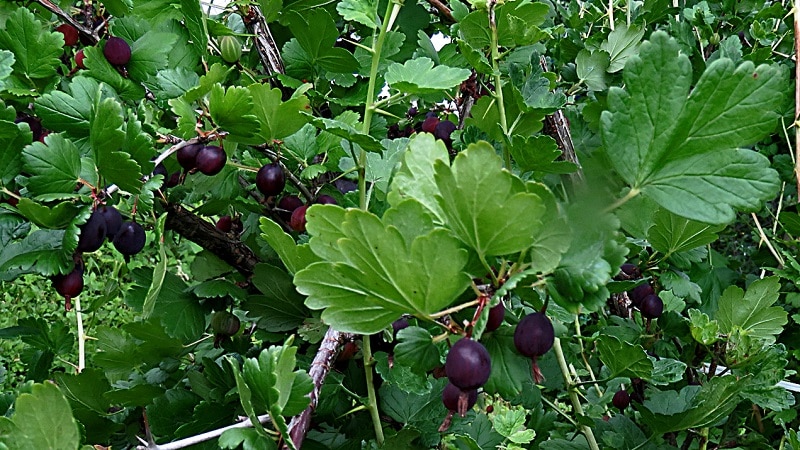
Temperature resistance
Bushes and fruit buds tolerate returning spring frosts and a decrease in air temperature in winter to -25°C, which indicates the possibility of successful cultivation of the variety both in central Russia and in northern regions with colder climates.
Moisture and drought resistance
Black Negus bushes experience short-term drought, but drying out of the soil negatively affects the quality and quantity of the harvest. Waterlogging of the soil leads to rotting of the root system.
Resistance to diseases and pests
The variety is resistant to powdery mildew and rust, but as a result of violation of care rules or due to unfavorable weather conditions, it can be affected by scab, various types of spotting, and anthracnose. Among the pests that pose a danger to the Black Negus are spider mites, aphids, gall midges, moths, moths, sawflies, borers, cutworms, etc.
Characteristics and description of fruits
The berries are pear-shaped, weigh no more than 2-2.5 g, covered with soft, hairless, greenish skin with a bluish waxy coating of medium thickness. After full ripening, the fruits become dark purple, almost black, matte.
The pulp is burgundy-red, characterized by a balanced sweet and slightly sour taste and a bright fruity aroma.
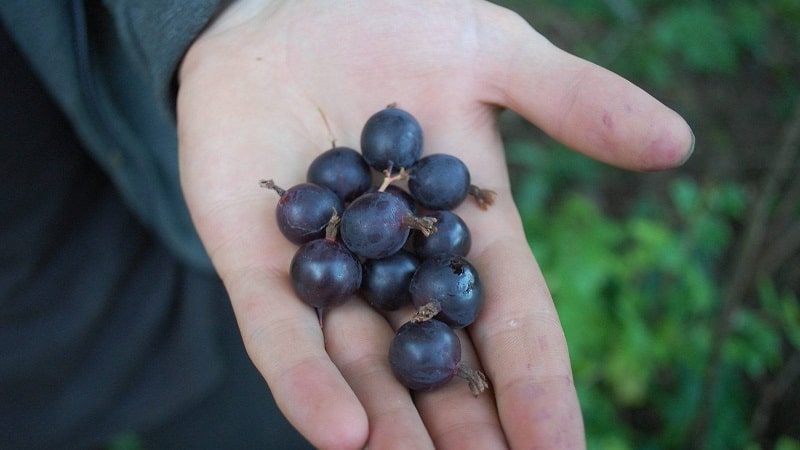
Areas of their application
Black negus forms fruits of universal use.The berries are consumed fresh, ground with sugar, and used to make jam, jam, juices, cocktails, compotes, liqueurs and wine.
Reference. Overripe fruits are suitable for making wine - they contain more sugar necessary for fermentation.
Advantages and disadvantages of the variety
The main advantages of the Black Negus gooseberry:
- high degree of frost resistance;
- adaptability to different climatic conditions;
- resistance to powdery mildew, rust;
- high productivity;
- pleasant, balanced taste of berries;
- lack of tendency to cracking and crumbling;
- long and regular fruiting;
- transportability, shelf life, possibility of universal use of the crop.
Among the disadvantages of the variety, only small fruit and strong thorny shoots are noted, which complicates harvesting and caring for bushes.
Growing technology
One of the undeniable advantages of this gooseberry is its unpretentiousness. Caring for Black Negus bushes involves proper planting of seedlings and compliance with standard agrotechnical requirements: timely watering, fertilization, pruning and preventive treatment of plants against diseases and pests.
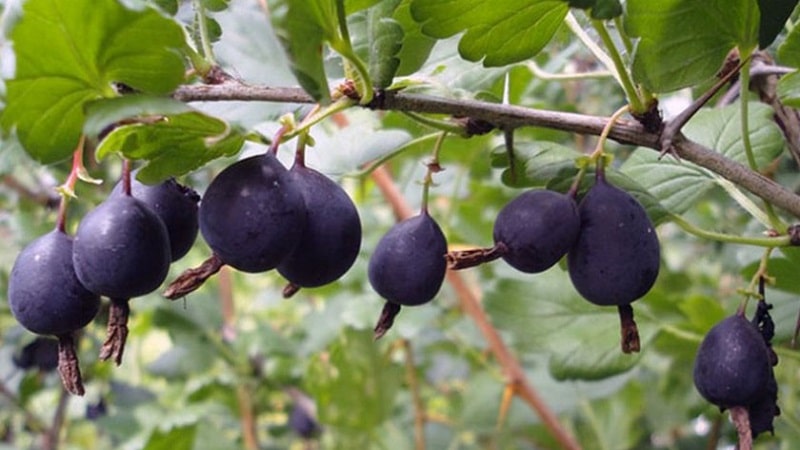
Optimal conditions
For planting choose an open, well-lit place, protected from gusty winds, with a groundwater depth of 0.9-2 m. The ideal figure is 1.5 m.
The variety does not have any special requirements for soil composition, but develops better in light, loose, fertile soil with a neutral or weak degree of acidity. The best option is sandstones and loams. Coarse river sand is first added to soil with a high clay content.
Reference. Gooseberries are not planted after raspberries and currants; the best predecessors are tomatoes, corn, eggplants, peppers, peas, potatoes, beans, grains or green manure.
Landing dates and rules
Landing of the Black Negus held in autumnwhen leaf fall begins. Spring planting is acceptable, but in this case the plants take root less well and are more susceptible to frost.
When choosing planting material, preference is given to 2-year-old seedlings with strong roots, without signs of disease, pest damage, rot or other damage. A day before planting, the root system of seedlings is soaked in a nutrient solution (4 tablespoons of sodium humate per 5 liters of water or 250 ml of Zircon per 1 liter of water).
Landing rules:
- Within 2 weeks, clear the selected area of debris and plant debris and dig deep.
- Form planting holes measuring 50x50 cm.
- Mix the excavated soil with humus or compost, add nitrogen and potassium-phosphorus fertilizers, for example nitrophoska at the rate of 250 ml per 1 bush.
- Pour the resulting soil mixture into the holes, place the seedling in the center, straighten its roots, sprinkle with soil, deepening the root collar by 5-6 cm.
- Water the plants, mulch the ground with a mixture of peat, sand and humus or freshly cut grass.
- Trim the shoots, leaving branches no more than 10 cm long with 5-6 buds.
Distance between bushes must be at least 1.5 m.
Further care
During dry periods gooseberries watered 3-5 times a month at the rate of 10 liters of water for each bush, with sufficient rainfall several times during the season: during flowering, at the beginning of berry formation, after harvesting and before wintering.
Reference. The sprinkling method is not used; water is poured strictly under the roots of the bushes.
Fertilizers are applied according to the scheme:
- spring - ammonium nitrate or urea (15-20 g per 1 sq. m);
- summer - wood ash (250 ml per 1 sq. m), potassium sulfate (20 g per 1 sq. m) or superphosphate (30 g per 1 sq. m);
- autumn - humus (5-6 kg per 1 sq. m).
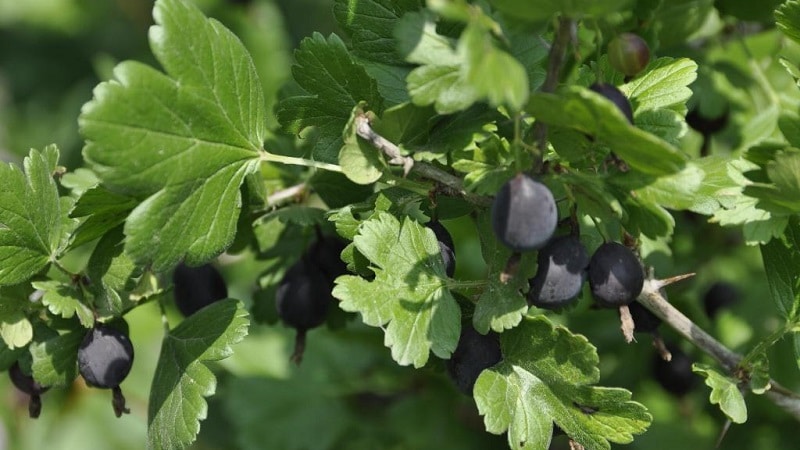
During the formation of berries, foliar feeding is used: 2 g of copper sulfate, 2.5 g of boric acid, 10 g of manganese sulfate, 3 g of zinc sulfate, 3 g of ammonium molybdate per 10 liters of water. Consumption - 2-3 per bush.
Due to the strong thorniness of the shoots when the plants are highly dense, care for them and harvest difficult, so they use the standard method of forming bushes. To do this, keep 1 vertical shoot as a conductor, cut off others near the ground, and then allow branching to be no lower than a height of 25-30 cm, removing the lower buds and root shoots. With this forming, the gooseberry is unstable, so it is tied to a support.
Also allowed standard trim, in which several shoots are preserved and periodically renewed. In the spring, to stimulate the growth of bushes, the central branches are shortened by 30%.
Sanitary pruning involves removing all old, weak, damaged shoots that grow inside the crown.
Possible problems, diseases, pests
Despite strong immunity, unfavorable weather conditions and violation of the rules of care lead to damage to the bushes by scab, rust, various spots, anthracnose and other diseases. Gooseberries suffer from attacks by pests: spider mites, aphids, gall midges, moths, moths, sawflies, borers, cutworms, etc.
For prevention development of diseases and pest attacks after the snow melts during the swelling of the buds and before the start of flowering, the bushes are sprayed with preparations with fungicidal, insecticidal and acaricidal effects: urea, copper sulfate, colloidal sulfur or biological products such as “Gaupsin”, “Trichodermin”, “Bitoxibacillin”, “Fitodoctor” and etc.
Wintering
Black Negus bushes do not need winter shelter. Pre-winter preparation for this variety of gooseberry consists of clearing the ground of fallen leaves, berries, weeds and other organic residues, abundant watering (at least 20 liters of water for each bush), digging the trunk circle with half a spade and mulching.
Reproduction
Gooseberry Black Negus propagated vegetatively:
- By layering. Select a strong, healthy young shoot growing at the bottom of the bush, bend it to the ground and sprinkle it with soil. After roots have formed on the layering at the site of bud formation, it is separated from the parent plant and planted in a permanent place.
- By shoots. On bushes older than 9 years, branches growing close to the base are cut off, and then they are rooted.
- Dividing the bush. A mother plant older than 8 years is dug up, divided into several parts so that each has a root system, and then planted in a permanent place.
Features of growing this variety depending on the region
In the southern regions, more frequent and abundant watering is required. In regions with little snowy winters, bushes for wintering are hilled up by adding a layer of earth 10-12 cm high around them.
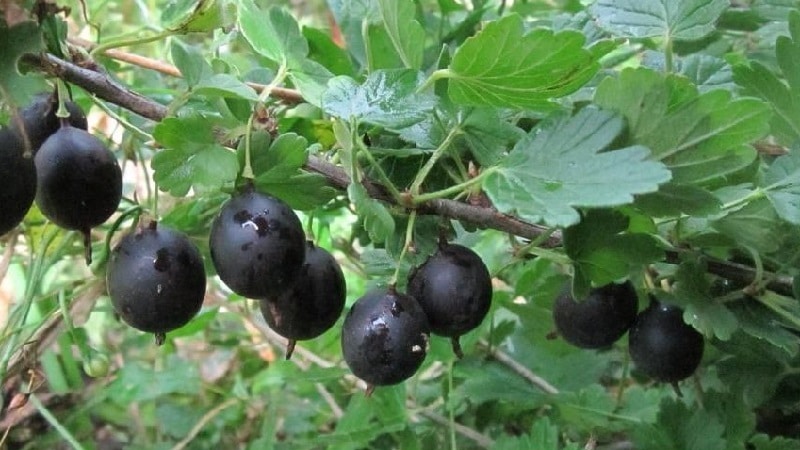
Pollinator varieties
Black Negus is a self-fertile variety of gooseberry. To set fruit, it does not need to be planted nearby pollinating varieties.
Reviews from summer residents
Gardeners fell in love with this gooseberry variety, which is confirmed by positive reviews.
Ekaterina, Bryansk: “A neighbor gave me several seedlings of the Black Negus. I planted them at the end of summer, and they did well until frost. Already 3 years after planting, we tried the berries of this gooseberry. It is not difficult to care for the bushes, but you need to get used to it because of the thorns. Overall, I’m satisfied with the variety.”
Maxim, Murmansk: “We have been growing this gooseberry for a long time - more than 10 years. The berries are small, of course, but this is a very minor drawback compared to the advantages of the variety. It’s not difficult to care for the bushes, they begin to bear fruit quickly and do so for a long time, the berries are tasty and sweet.”
Irina, Podolsk: “My godfather bought seedlings of the Black Negus, and I also decided to take a couple. I planted them in early September and by winter they had taken root well. The first harvest, although very small, was harvested in the 4th year, and then there were much more berries. Gooseberries are very tasty, my grandchildren adore them.”
Conclusion
Gooseberry Black Negus has gained popularity among gardeners, although it was not originally intended for widespread use. This variety is resistant to frost, powdery mildew and rust, and is characterized by high yield and a dessert, balanced taste of berries. There are few disadvantages: small fruit and a large number of sharp thorns on the shoots.